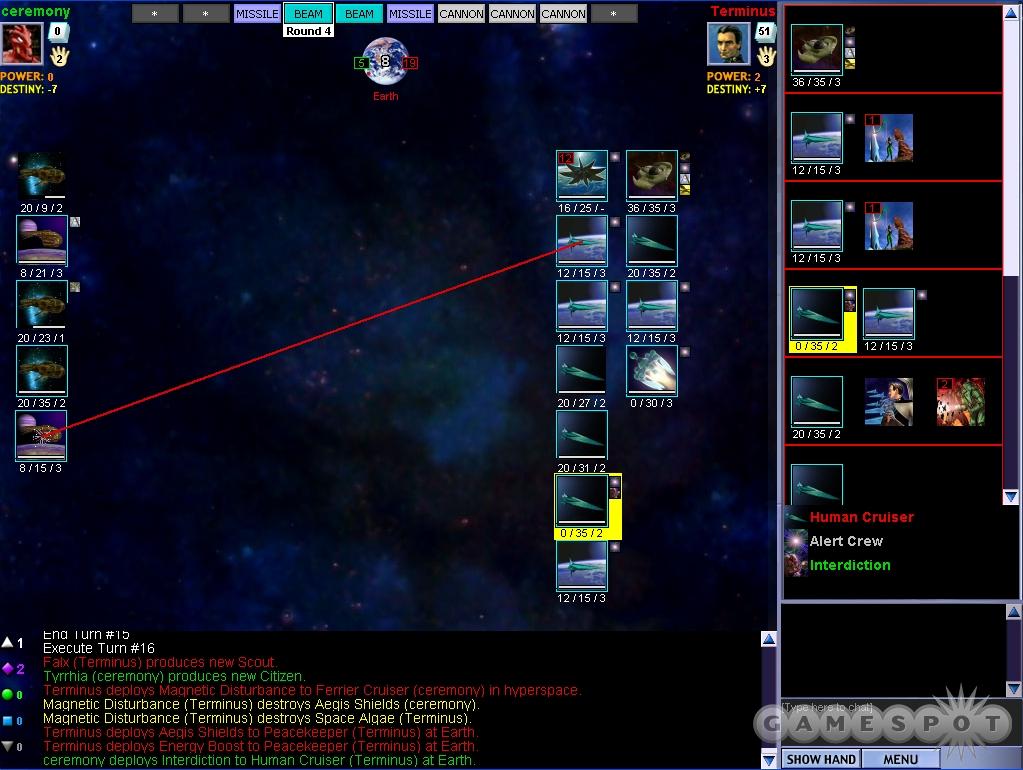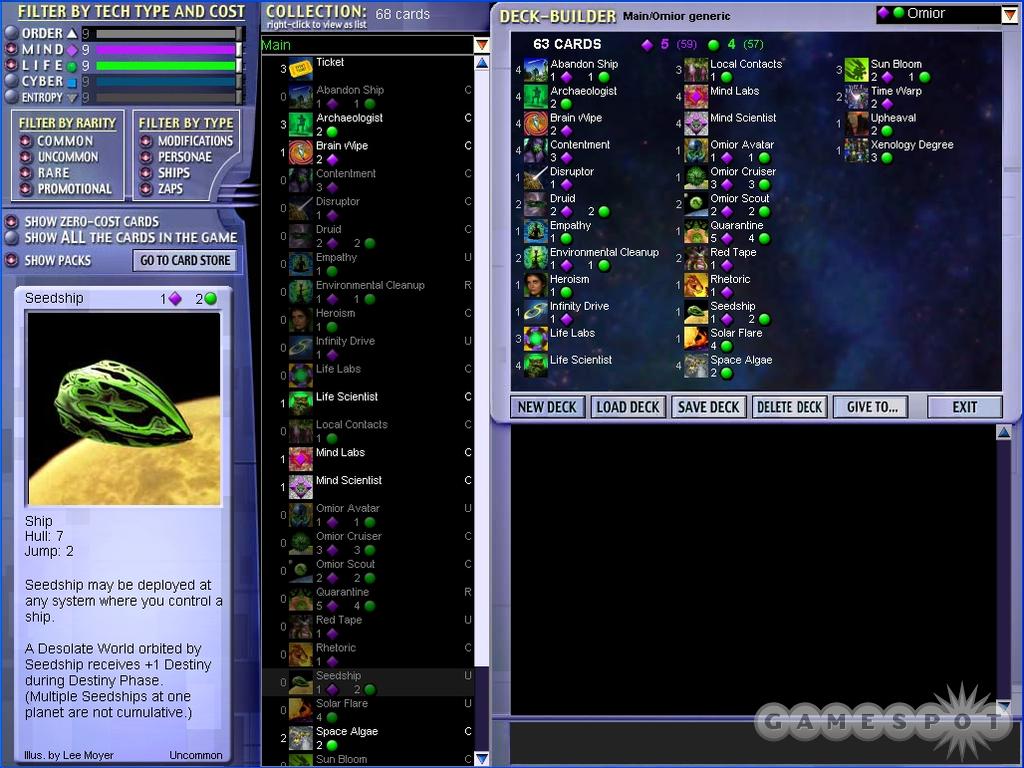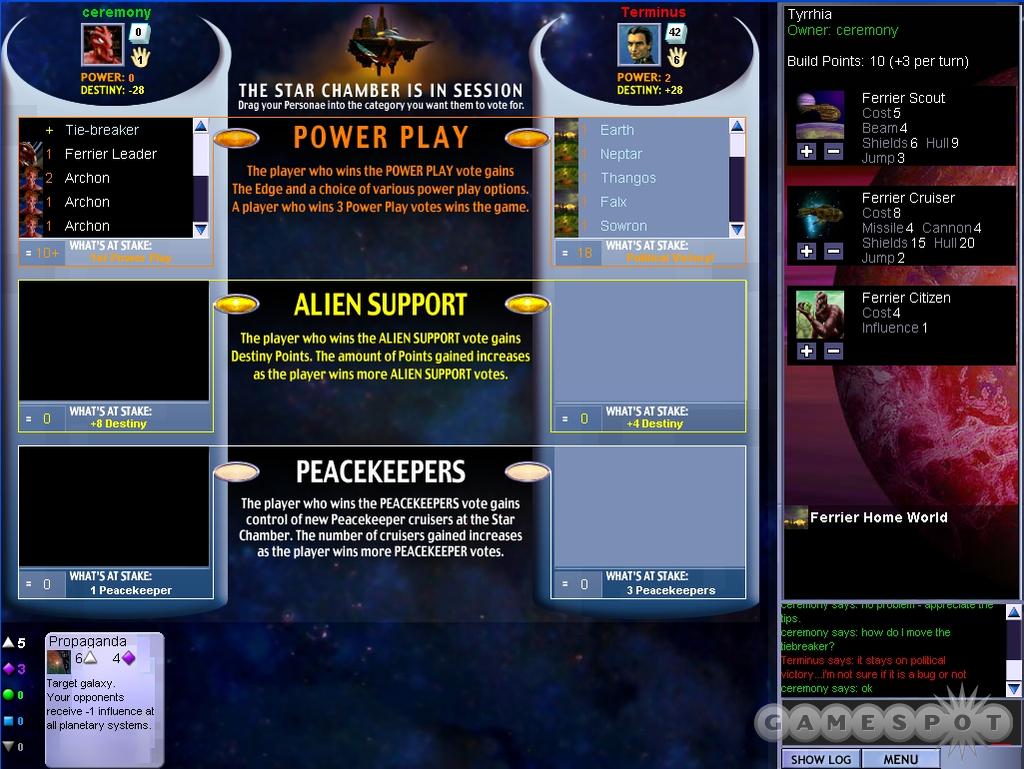Let's get this out of the way up front: Star Chamber is great. What's more, it's great because it combines elegance, interesting gameplay choices, and the attraction of card-collecting in what has to be one of the very best pure game designs of the year.

Star Chamber isn't flashy, but its presentation works well. It's essentially a board game with a heavy collectible card game component. However, whereas some such games use the game board simply as a tool to provide opportunities for duels between players who are using the cards, Star Chamber makes the board game the focus of the design and integrates the collectible cardplay in such a way that you can't separate them. The cards have no meaning without the context of the game board, yet without them, the board game aspect would be sterile and much less interesting. It's a testament to how well designed the game is that when combined, these two aspects make for a game that is much better than the sum of the parts.
The game is played out on a stylized board that consists of different types of planets, which are connected by jump lanes of variable length. There are artifact planets that generate something called "destiny," industrial worlds that generate production, and barren worlds that are just waiting for cards to be played on them, which can transform them into producers of valuable resources, such as technology. Asteroid fields and nebulae act as locations with special properties. Because everything is visible, players can see an opponent's position (but not his or her hand) and thus Star Chamber plays very much like a board game.
There are three separate ways to win the game, and this contributes to the game's incredible depth. You can achieve a military victory by conquering your opponent's homeworld; a cultural victory by amassing 30 more destiny points than your foe; or a political victory by winning three "power play" votes in the Star Chamber. This name refers to the political body represented in the game by a central location on the map, where no combat is allowed between opposing fleets and where players vie for influence to win votes that may bring them closer to political victory, closer to amassing destiny, or closer to gaining control of additional starships. Because winning these votes gains advantages that are not limited to single methods of victory, the Star Chamber mechanism is extremely flexible. This wealth of choices, all of which relate to every other part of the game, makes Star Chamber one of the year's outstanding strategy games.
The unit types and production rules are simple: planets can produce ships and citizens. Citizens control planets and confer voting privileges in the Star Chamber, while ships transport citizens, fight other ships, and blockade planets. Because there is no way (outside of a few specialized cards) to destroy citizens on a planet unless you go to a state of war, which allows you to produce bombers but costs you destiny, the tension between space power and planet control/voting strength is one of the game's central dilemmas, and it's yet another example of the outstanding design.
Ship combat is--like the rest of the game--very straightforward and not very luck-dependent. There are basically two classes of ships available to build (scouts and cruisers, although bombers appear once war has been declared) with slightly different characteristics for each race, as well as larger ships (dreadnoughts) than can be acquired via cardplay. Ships are rated for beam, missile, and cannon attack, and combat proceeds through a number of rounds where different types of weapons are fired in turn, so you can always tell how much damage a ship will do in a given round. The only luck factor is in targeting, because this is done randomly based on the relative strength of opposing ships and their damage state. Otherwise, it's clear how much damage a ship can inflict--and how much damage it is likely to sustain--in a given combat, and thus gaining advantages in combat relies on the skill of each player.

The fact that we haven't described how the card system works until now demonstrates just how important the board game aspect is. However, the card portion is crucial, and it's what makes the game appealing, both in terms of strategy and in the attraction of collecting and trading the cards necessary to build better decks. There are five different colors ("techs") in the game, and each of the nine available races uses two techs. However, capturing artifact planets allows you to choose from any of the five techs, which that planet will then produce for you as long as you control it, and there are cards that allow you to produce non-native techs on some planets. Consequently, it is possible to create multicolor decks that incorporate some interesting combinations, and you're not limited to your race's techs unless you choose to be. The different races each have a unique characteristic (like cheaper citizens for humans in certain cases, or one free destiny each turn for the omior) that further affects strategy.
Describing the variety of cards in detail would be both impossible and pointless. Let it suffice to say that the cards serve to enhance and develop the underlying board game mechanics so that ships may have their shields, hull points, or jump factors increased; citizens may increase their influence; heroes can be created to lead fleets in battle; and any number of tricks and traps can be introduced. To defend a system, you can use cards to build new ships, or you can, perhaps, use a tractor beam to keep a powerful ship in an enemy fleet from making the jump to hyperspace. You can give personae more influence (to control planets or give more votes in the Star Chamber), cause planets to generate more destiny, or any number of other things. Almost all of the game mechanics can be affected by cardplay, which makes the game playable in many different styles since the victory objectives are so different. The fact that the game mechanics are anchored in the boardplay helps keep the cardplay unambiguous, since everything is laid out on the board, and there is no need to generate new types of units, card classes, or abstract relationships between cards.
The balance between combat, diplomacy, planet control, and tech generation is what makes Star Chamber such a superlative design and not just a collection of good ideas. Even a good strategy has possible counterstrategies, and the fact that the board game has some fixed characteristics in terms of objectives means that deficiencies in deck makeup can sometimes be made up for by skilled manipulation of the units of the board. The boards themselves are quite varied, and a good deck on one board may have limitations on another. This is where the ability to master the deck-building, cardplay, and board game aspects of Star Chamber comes into play, although due to the brilliance of the design, these elements are really inseparable.

If the game's implementation has any weaknesses, it's that it demands the accessibility to information available in a board game, but the game interface doesn't always provide this. It's hard to get information at a glance. For example, an opponent may have several ships and personae in a stack, which you can't examine without clicking on them, and then they may have multiple modifications (cards) played on them that require further clicking. The game is not very visually clear in this way, unlike a good board game where you can assimilate a position at a glance. This is due to a combination of the game's complexity and the slightly cramped interface. With timed turns that are short, this can lead to a lot of quick clicking. The turn timer can be disabled, and since turns are processed simultaneously, you're not always forced to wait for the other person to play his turn, but it is still possible to end up waiting a while for an opponent to move. Fortunately, the game community, so far, is uniformly polite and helpful, and it's very supportive of new players.
The game is available as a small, free download from the official Star Chamber Web site. The download gives you access to the game (everything takes place online), including sample decks for a limited number of races, as well as the ability to play all comers in head-to-head play, which is in addition to solo games against a very limited AI opponent. The AI isn't really competitive, and a newbie should be able to win handily against the easy (balanced) setting every time. The medium and hard settings are more difficult, but this is solely due to the fact that the opening board position on these settings is stacked against you; the AI plays no better. Thus, the solo mode is really only useful (once you've learned the rules) for testing card draws in new decks that you've built and not much more.
So you can play for free for as long as you want, but the only way to become competitive is--like with any collectible card game--to buy new cards. Nayantara Studios provides several ways to get into the game. First, there is the card store, where you can buy booster packs in various quantities. These packs contains 15 cards each and cost anywhere from $5.99 for three packs (about $2 per pack) to $49.99 for 36 packs plus six event tickets. Alternately, there is a subscription available, which costs $5.99 per month and gets you two booster packs, two event tickets, and two special promo cards each month. A subscription also gives you the ability to play in regular "pro circuit" tournaments. If you just want to make a one-time investment at a reasonable price, for $29.99 you can buy a "pack attack" of 21 boosters and three tickets, which makes you competitive and gives you enough cards to build many different decks using all of the available nine races.
Event tickets can be used to enter the weekly sealed-deck tournaments, which are probably the best way to experience Star Chamber. For a single ticket ($1 cost) you get the temporary use of the cards from seven booster packs, and you get the right to compete in a Swiss-format tournament where you'll be guaranteed three games and the opportunity to win prizes. The contents of seven packs are generally not enough to build a straight two-color deck, so skill in deck-building and gameplay are paramount here.

Currently, the biggest downside to Star Chamber is simply that few people are playing it. Finding a player of similar level is a hit-or-miss proposition, and it's not unusual to log on at peak times and find only two or three players available for a game, one or both of whom might be ex-play testers with large collections or high skill (or both). The best way to enjoy the game right now is to convince a friend to join with you so that you learn together and can share tips and trade cards. Games rarely take longer than 30 minutes, so it's an excellent way to enjoy quality online gaming with friends when you both have busy schedules.
This critical mass--regarding a lack of Star Chamber players--is the only thing that is of enough concern to keep us from making an unqualified recommendation of this fine game. As it currently stands, a one-time investment of $29.99 gets you dozens of hours of gameplay. Twenty-one packs can generate multiple competitive decks over the various races, and as you learn the game, you'll be able to hone your decks over and over. Additionally, you'll add further colors, and you'll generate new decks as you become more familiar and more comfortable with both multicolor play and some of the more challenging races. For $50, which is the price of many new retail games, you get 35 packs and enough gameplay to last for months--which is more than you can expect from most games these days. Star Chamber may be a low-profile release from a small developer, but in providing high quality gaming entertainment at an attractive price, it has few peers in the industry.